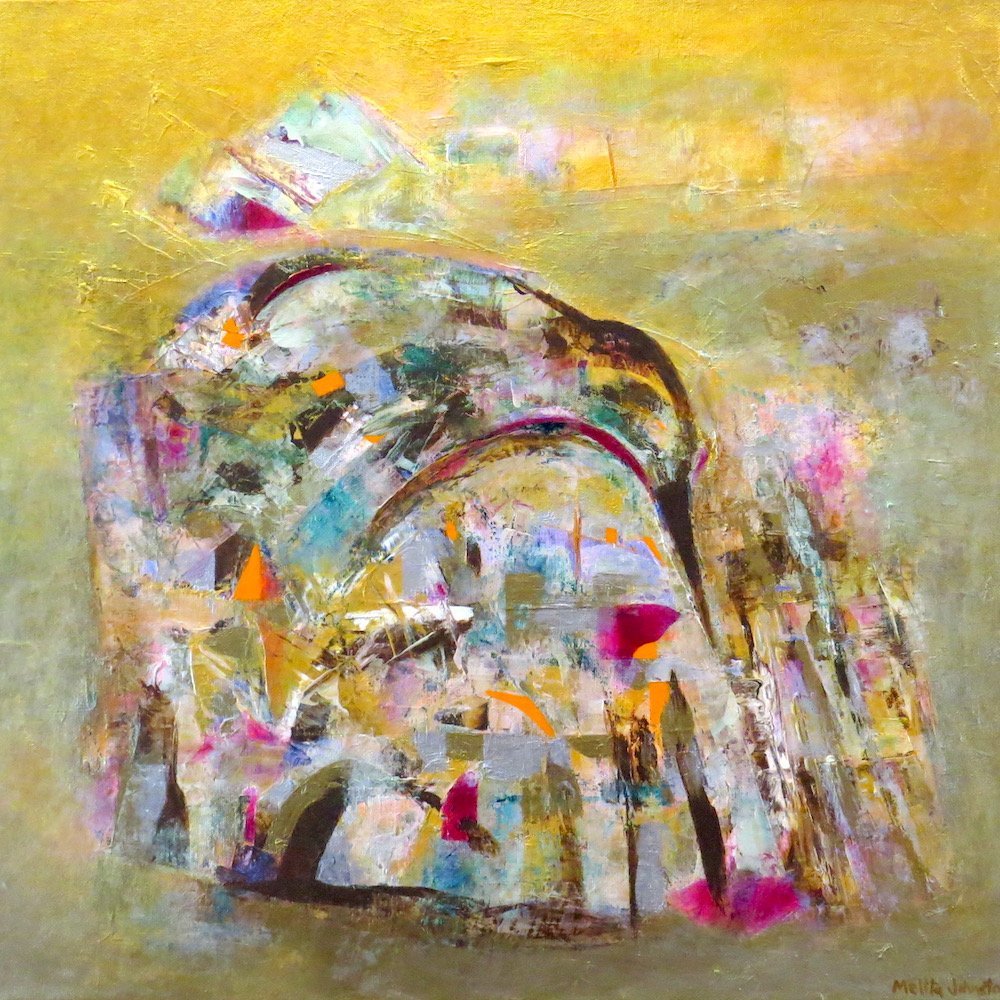In this week's Art Seen, James Dignan looks at exhibitions from Pea Sea Art, The Artist’s Room and Blue Oyster Art Project Space.
 Twinkle, by Melita Johnston.
"Time and Hope — Connected with Colour and Shape", Melita Johnston (Pea Sea Art)
Twinkle, by Melita Johnston.
"Time and Hope — Connected with Colour and Shape", Melita Johnston (Pea Sea Art)

Melita Johnson’s exhibition at Pea Sea Art is, in the artist’s own words, "an invitation to reflect on time and hope".
The paintings, which combine elements of gestural abstraction and landscape, take the turmoil of the modern world and place it, enclosed, against calm geometric backgrounds suggesting simple horizon lines and clear blue skies.
The works are created by a combination of brush and palette knife; the knife strokes giving the enclosed heavily worked areas a feeling of dynamic chaos, which is brought into even sharper relief by the calmness of the surrounding brushed backdrops. The liberal use of metallic paints adds to the apparent motion, with the works changing appearance as the light hits them at different angles. Some of the pieces have a more overt representational appearance, notably the outlined kiwi of Twinkle.
The canvas works are complemented by a series of more sketch-like paintings on archival paper, which, while clearly created more quickly (while the artist was recovering from an injury), have a charm of their own, and an immediacy which is lacking from some of the more deliberated works. Also on display are two found ceramic kiwis which have been painted in solid colours by the artist. These become almost talismanic tekoteko, watching over and protecting the exhibition.
 The Gossip from the Riverbank, by Jane Siddall.
"Childhood Wonder", Jane Siddall and Claire Te Au (The Artist’s Room)
The Gossip from the Riverbank, by Jane Siddall.
"Childhood Wonder", Jane Siddall and Claire Te Au (The Artist’s Room)

"Childhood Wonder" is a joint exhibition by Jane Siddall and Claire Te Au. Both present brightly coloured works featuring animals and flowers, and although their techniques and media are disparate, their images complement each other nicely.
Siddall’s work, while initially appearing to be painted, is created from coloured graphite. This gives the lie to any suggestion that the pieces may be inspired by creating and elaborating on Rorschach test-like inkblots. The works are roughly but not entirely symmetrical, and the choice of colour and the impressive sheen and glow of the flower petals give the drawings an almost gouache-like appearance. The animals which take centre stage are stylishly and finely presented, creating charming drawings that make strong use of the white negative space which surrounds the images.
Claire Te Au’s work is in some ways the exact opposite of Siddall’s. While clearly painted, the crispness of the blooms has an almost drawing-like quality. Here, it is the flowers which originally grab the viewer’s attention, and it is only after a while that the animals within the images reveal themselves. The title Hide and Seek of one of the works is perfectly appropriate, with the magic realism of foxes, goldfish, turtles, and comical yet realistic frogs suddenly emerging from among the blooms.
 Aim to Miss (detail), by Harrison Freeth.
"The Blue Oyster Artist-Run Gym", (Blue Oyster Art Project Space)
Aim to Miss (detail), by Harrison Freeth.
"The Blue Oyster Artist-Run Gym", (Blue Oyster Art Project Space)

There is a whimsical and slightly cynical rationale behind the various "exercise routines" at Blue Oyster Art Project Space’s "artist-run gym", several of which are interactive.
The show, put together by several artists and collectives from around New Zealand, compares the process of creating art (and especially the bureaucracy around gaining both funding and recognition) with the strenuous workouts associated with fitness regimes. In the exhibition, the gallery space becomes a gymnasium, complete with climbing wall, exercise bike, and archery range.
Anna-Marie Mirfin, in collaboration with a group of local ceramicists, has produced a climbing wall from glazed stoneware for artists to practice their "social climbing". Beside this, Samantha Mitchell’s meditation area and exercycle with virtual road video are both accompanied by soundtracks, calming and upbeat respectively, which present their exercise aims through a series of deliberately cliched texts reflecting the language used in grants applications.
Perhaps the piece which works best is Harrison Freeth’s Aim to Miss, with its construction of printed target and misdirected charcoal arrows representing the "firing into the unknown" of the artistic process.
In the second gallery space, Wellington collective E-Kare's "Point-and-click Adventure" presents a poem in video-game form. Gallery visitors can guide themselves through the poetic text by playing the game.












